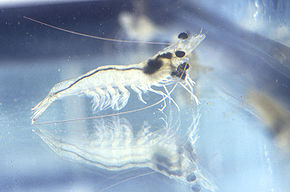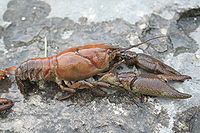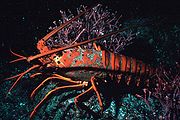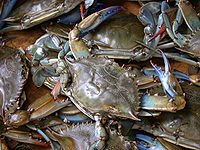
Decapoda
Encyclopedia
The decapods or Decapoda (literally "ten-footed") are an order of crustacean
s within the class Malacostraca
, including many familiar groups, such as crayfish
, crab
s, lobster
s, prawn
s and shrimp
. Most decapods are scavenger
s. It is estimated that the order contains nearly 15,000 species in around 2,700 genera, with approximately 3,300 fossil species. Nearly half of these species are crabs, with the shrimp ( species) and Anomura
(including hermit crab
s, porcelain crab
s, squat lobster
s: species), making up the bulk of the remainder. The earliest fossil
decapod is the Devonian
Palaeopalaemon.
, , "ten", and , -pod, "foot") implies, all decapods have ten legs. These are in the form of five pairs of thoracic appendages on the last five thoracic segments. The front three pairs function as mouthparts and are generally referred to as maxillipeds; the remainder are pereiopods. In many decapods, however, one pair of legs has enlarged pincers; the claws are called chelae
, so those legs may be called chelipeds. Further appendages are found on the abdomen, with each segment capable of carrying a pair of biramous pleopods, the last of which form part of the tail fan (together with the telson
) and are called uropods.
s and legs, and the way in which the larva
e develop, giving rise to two suborders: Dendrobranchiata and Pleocyemata
. Dendrobranchiata consists of prawn
s, including many species colloquially referred to as "shrimp", such as the "white shrimp", Litopenaeus setiferus. Pleocyemata includes the remaining groups, including true shrimp
. Those groups which usually walk rather than swim (Pleocyemata, excluding Stenopodidea and Caridea) form a clade called Reptantia.
The following classification to the level of superfamilies follows De Grave et al.




 Order Decapoda Latreille, 1802
Order Decapoda Latreille, 1802
Crustacean
Crustaceans form a very large group of arthropods, usually treated as a subphylum, which includes such familiar animals as crabs, lobsters, crayfish, shrimp, krill and barnacles. The 50,000 described species range in size from Stygotantulus stocki at , to the Japanese spider crab with a leg span...
s within the class Malacostraca
Malacostraca
Malacostraca is the largest of the six classes of crustaceans, containing over 25,000 extant species, divided among 16 orders. Its members display a greater diversity of body forms than any other class of animals, and include crabs, lobsters, shrimp, krill, woodlice, scuds , mantis shrimp and many...
, including many familiar groups, such as crayfish
Crayfish
Crayfish, crawfish, or crawdads – members of the superfamilies Astacoidea and Parastacoidea – are freshwater crustaceans resembling small lobsters, to which they are related...
, crab
Crab
True crabs are decapod crustaceans of the infraorder Brachyura, which typically have a very short projecting "tail" , or where the reduced abdomen is entirely hidden under the thorax...
s, lobster
Lobster
Clawed lobsters comprise a family of large marine crustaceans. Highly prized as seafood, lobsters are economically important, and are often one of the most profitable commodities in coastal areas they populate.Though several groups of crustaceans are known as lobsters, the clawed lobsters are most...
s, prawn
Prawn
Prawns are decapod crustaceans of the sub-order Dendrobranchiata. There are 540 extant species, in seven families, and a fossil record extending back to the Devonian...
s and shrimp
Shrimp
Shrimp are swimming, decapod crustaceans classified in the infraorder Caridea, found widely around the world in both fresh and salt water. Adult shrimp are filter feeding benthic animals living close to the bottom. They can live in schools and can swim rapidly backwards. Shrimp are an important...
. Most decapods are scavenger
Scavenger
Scavenging is both a carnivorous and herbivorous feeding behavior in which individual scavengers search out dead animal and dead plant biomass on which to feed. The eating of carrion from the same species is referred to as cannibalism. Scavengers play an important role in the ecosystem by...
s. It is estimated that the order contains nearly 15,000 species in around 2,700 genera, with approximately 3,300 fossil species. Nearly half of these species are crabs, with the shrimp ( species) and Anomura
Anomura
Anomura is a group of decapod crustaceans, including hermit crabs and others. Although the names of many anomurans includes the word crab, all true crabs are in the sister group to the Anomura, the Brachyura .-Description:The name Anomala reflects the unusual variety of forms in this group;...
(including hermit crab
Hermit crab
Hermit crabs are decapod crustaceans of the superfamily Paguroidea. Most of the 1100 species possess an asymmetrical abdomen which is concealed in an empty gastropod shell that is carried around by the hermit crab.-Description:...
s, porcelain crab
Porcelain crab
Porcelain crabs are decapod crustaceans in the widespread family Porcellanidae, which superficially resemble true crabs. They are typically less than wide, and have flattened bodies as an adaptation for living in rock crevices...
s, squat lobster
Squat lobster
Squat lobsters are decapod crustaceans of the families Galatheidae, Chirostylidae and Kiwaidae, including the common genera Galathea and Munida. They are not lobsters at all, but are more closely related to porcelain crabs, hermit crabs and then, more distantly, true crabs...
s: species), making up the bulk of the remainder. The earliest fossil
Fossil
Fossils are the preserved remains or traces of animals , plants, and other organisms from the remote past...
decapod is the Devonian
Devonian
The Devonian is a geologic period and system of the Paleozoic Era spanning from the end of the Silurian Period, about 416.0 ± 2.8 Mya , to the beginning of the Carboniferous Period, about 359.2 ± 2.5 Mya...
Palaeopalaemon.
Anatomy
As the name Decapoda (from the GreekGreek language
Greek is an independent branch of the Indo-European family of languages. Native to the southern Balkans, it has the longest documented history of any Indo-European language, spanning 34 centuries of written records. Its writing system has been the Greek alphabet for the majority of its history;...
, , "ten", and , -pod, "foot") implies, all decapods have ten legs. These are in the form of five pairs of thoracic appendages on the last five thoracic segments. The front three pairs function as mouthparts and are generally referred to as maxillipeds; the remainder are pereiopods. In many decapods, however, one pair of legs has enlarged pincers; the claws are called chelae
Chela (organ)
A chela is a pincer-like organ terminating certain limbs of some arthropods. The name comes from Greek through New Latin . The plural form is chelae. Legs bearing a chela are called chelipeds. Another name is claw because most chelae are curved and have a sharp point like a claw....
, so those legs may be called chelipeds. Further appendages are found on the abdomen, with each segment capable of carrying a pair of biramous pleopods, the last of which form part of the tail fan (together with the telson
Telson
The telson is the last division of the body of a crustacean. It is not considered a true segment because it does not arise in the embryo from teloblast areas as do real segments. It never carries any appendages, but a forked "tail" called the caudal furca is often present. Together with the...
) and are called uropods.
Classification
Classification within the order Decapoda depends on the structure of the gillGill
A gill is a respiratory organ found in many aquatic organisms that extracts dissolved oxygen from water, afterward excreting carbon dioxide. The gills of some species such as hermit crabs have adapted to allow respiration on land provided they are kept moist...
s and legs, and the way in which the larva
Larva
A larva is a distinct juvenile form many animals undergo before metamorphosis into adults. Animals with indirect development such as insects, amphibians, or cnidarians typically have a larval phase of their life cycle...
e develop, giving rise to two suborders: Dendrobranchiata and Pleocyemata
Pleocyemata
Pleocyemata is a sub-order of decapod crustaceans, erected by Martin Burkenroad in 1963. Burkenroad's classification replaced the earlier sub-orders of Natantia and Reptantia with the monophyletic groups Dendrobranchiata and Pleocyemata...
. Dendrobranchiata consists of prawn
Prawn
Prawns are decapod crustaceans of the sub-order Dendrobranchiata. There are 540 extant species, in seven families, and a fossil record extending back to the Devonian...
s, including many species colloquially referred to as "shrimp", such as the "white shrimp", Litopenaeus setiferus. Pleocyemata includes the remaining groups, including true shrimp
Shrimp
Shrimp are swimming, decapod crustaceans classified in the infraorder Caridea, found widely around the world in both fresh and salt water. Adult shrimp are filter feeding benthic animals living close to the bottom. They can live in schools and can swim rapidly backwards. Shrimp are an important...
. Those groups which usually walk rather than swim (Pleocyemata, excluding Stenopodidea and Caridea) form a clade called Reptantia.
The following classification to the level of superfamilies follows De Grave et al.





- Suborder Dendrobranchiata Bate, 1888
- PenaeoideaPenaeoideaPenaeoidea is the larger of the two superfamilies of prawns. It comprises eight families, three of which are known only from fossils. The fossil record of the group stretches back to Aciculopoda, discovered in Famennian sediments in Oklahoma....
Rafinesque, 1815 - SergestoideaSergestoideaSergestoidea is a superfamily of prawns, divided into two families – the Luciferidae and the Sergestidae....
Dana, 1852
- Penaeoidea
- Suborder PleocyemataPleocyemataPleocyemata is a sub-order of decapod crustaceans, erected by Martin Burkenroad in 1963. Burkenroad's classification replaced the earlier sub-orders of Natantia and Reptantia with the monophyletic groups Dendrobranchiata and Pleocyemata...
Burkenroad, 1963- Infraorder StenopodideaStenopodideaThe Stenopodidea is a small group of decapod crustaceans. Often confused with shrimp or prawns, they are neither, but belong in a group closer to the reptant decapods, such as lobsters and crabs. They may be easily recognised by their third pereiopod , which is greatly enlarged...
Bate, 1888 - Infraorder Caridea Dana, 1852
- ProcaridoideaProcaridoideaProcaridoidea is a superfamily of shrimp, comprising only eleven species. Six of these are in the genera Procaris and Vetericaris, which together make up the family Procarididae. The remaining five species are only known from fossils and belong to the genus Udora, which cannot yet be assigned to...
Chace & Manning, 1972 - Galatheacaridoidea Vereshchaka, 1997
- Pasiphaeoidea Dana, 1852
- Oplophoroidea Dana, 1852
- Atyoidea De Haan, 1849
- BresilioideaBresilioideaBresilioidea is a superfamily of shrimp. It is likely to be an artificial group, containing five families which may or may not be related....
Calman, 1896 - NematocarcinoideaNematocarcinoideaNematocarcinoidea is a superfamily of shrimp, comprising three families – Eugonatonotidae, Nematocarcinidae and Rhynchocinetidae. They share the presence of strap-like epipods on at least the first three pairs of pereiopods, and a blunt molar process. The family Xiphocarididae was formerly included....
Smith, 1884 - Psalidopodoidea Wood-Mason, 1874
- Stylodactyloidea Bate, 1888
- CampylonotoideaCampylonotoideaCampylonotoidea is a superfamily of shrimp, containing the two families Campylonotidae and Bathypalaemonellidae. Fenner A. Chace considered it to be the sister group to the much larger superfamily Palaemonoidea, with which it shares the absence of endopods on the pereiopods, and the fact that the...
Sollaud, 1913 - PalaemonoideaPalaemonoideaPalaemonoidea is a large superfamily of shrimp, containing nearly 1,000 species.*Anchistioididae Borradaile, 1915*Desmocarididae Borradaile, 1915*Euryrhynchidae Holthuis, 1950*Gnathophyllidae Dana, 1852*Hymenoceridae Ortmann, 1890...
Rafinesque, 1815 - AlpheoideaAlpheoideaAlpheoidea is a superfamily of shrimp containing the families Alpheidae, Barbouriidae and Hippolytidae....
Rafinesque, 1815 - Processoidea Ortmann, 1896
- PandaloideaPandaloideaPandaloidea is a superfamily of shrimp, comprising the large family Pandalidae and the much smaller Thalassocarididae ....
Haworth, 1825 - Physetocaridoidea Chace, 1940
- CrangonoideaCrangonoideaCrangonoidea is a superfamily of shrimps containing the two families Crangonidae and Glyphocrangonidae....
Haworth, 1825
- Procaridoidea
- Infraorder AstacideaAstacideaAstacidea is a group of decapod crustaceans including lobsters, crayfish and their close relatives. It comprises five extant superfamilies, two of crayfish , one of true lobsters , one of reef lobsters , and a number of fossil taxa...
Latreille, 1802- Enoplometopoidea de Saint Laurent, 1988
- NephropoideaNephropoideaNephropoidea is a superfamily of decapod crustaceans. It contains the true lobsters in the Nephropidae , and three fossil families: Chilenophoberidae, Protastacidae and Stenochiridae. Their closest relatives are the reef lobsters....
Dana, 1852 - Astacoidea Latreille, 1802
- Parastacoidea Huxley, 1879
- Infraorder GlypheideaGlypheideaGlypheidea is an infra-order of decapod crustaceans, comprising a number of fossil forms and the two extant genera Neoglyphea and Laurentaeglyphea:Glypheoidea Winckler, 1882*† Chimaerastacidae Amati, Feldmann & Zonneveld, 2004...
Winckler, 1882- GlypheoideaGlypheoideaThe Glypheoidea , is a group of lobster-like decapod crustaceans which forms an important part of fossil faunas, such as the Solnhofen limestone. These fossils included taxa such as Glyphea , and Mecochirus, mostly with elongated chelipeds...
Winckler, 1882
- Glypheoidea
- Infraorder Axiidea de Saint Laurent, 1979b
- Infraorder Gebiidea de Saint Laurent, 1979
- Infraorder AchelataAchelataThe Achelata is an infra-order of the reptant Decapoda. It contains the spiny lobsters , the slipper lobsters and the furry lobsters...
Scholtz & Richter, 1995 - Infraorder PolychelidaPolychelidaPolychelida is a group of decapod crustaceans. Fossil representatives are known dating from as far back as the Upper Triassic. A total of 38 extant species, all in the family Polychelidae, and 55 fossil species have been described....
Scholtz & Richter, 1995 - Infraorder AnomuraAnomuraAnomura is a group of decapod crustaceans, including hermit crabs and others. Although the names of many anomurans includes the word crab, all true crabs are in the sister group to the Anomura, the Brachyura .-Description:The name Anomala reflects the unusual variety of forms in this group;...
MacLeay, 1838- Aegloidea Dana, 1852
- GalatheoideaGalatheoideaGalatheoidea is a superfamily of decapod crustaceans comprising some squat lobsters and the porcelain crabs. Two other families of squat lobsters, Chirostylidae and Kiwaidae, are not closely related to the members of Galatheoidea, and are now placed in other superfamilies...
Samouelle, 1819 - HippoideaHippoideaHippoidea is a superfamily of decapod crustaceans known as sand crabs or mole crabs.-Ecology:Hippoids are adapted to burrowing into sandy beaches, a habit they share with raninid crabs, and the parallel evolution of the two groups is striking...
Latreille, 1825a - Kiwaoidea Macpherson, Jones & Segonzac, 2005
- Lithodoidea Samouelle, 1819
- Lomisoidea Bouvier, 1895
- Paguroidea Latreille, 1802
- Infraorder Brachyura Linnaeus, 1758
- Section DromiaceaDromiaceaDromiacea is a group of crabs, ranked as a section. It contains 240 extant and nearly 300 extinct species. Where they are considered to form a monophyletic group, Dromiacea and two other groups of crabs, namely the Raninoida and Cyclodorippoidea, may be collected together into the Podotremata, each...
De Haan, 1833- DromioideaDromioideaDromioidea is a superfamily of crabs mostly found in Madagascar. The earliest fossils attributable to the Dromioidea date from the Danian....
De Haan, 1833 - Homolodromioidea Alcock, 1900
- HomoloideaHomoloideaHomoloidea is a superfamily of dromiacean crabs. The close relation between Homoloidea and Dromioidea is primarily established through ultrastructural characteristics of the sperm ....
De Haan, 1839
- Dromioidea
- Section Raninoida De Haan, 1839
- Section Cyclodorippoida Ortmann, 1892
- Section EubrachyuraEubrachyuraEubrachyura is a group of crustaceans comprising the more advanced crabs. It is divided into two subsections, based on the position of the genital openings in the two sexes. In the Heterotremata, the openings are on the legs in the males, but on the sternum in females, while in the Thoracotremata,...
de Saint Laurent, 1980- Subsection HeterotremataHeterotremataHeterotremata is a clade of crabs, comprising those crabs in which the genital openings are on the sternum in females, but on the legs in males. It comprises 68 families in 28...
Guinot, 1977- Aethroidea Dana, 1851
- Bellioidea Dana, 1852
- Bythograeoidea Williams, 1980
- CalappoideaCalappoideaCalappoidea is a superfamily of crabs comprising the two families Calappidae and Matutidae. The earliest fossils attributable to the Callpoidea date from the Aptian....
De Haan, 1833 - CancroideaCancroideaCancroidea is a superfamily of crabs, comprising the families Atelecyclidae and Cancridae. Two families previously included in this superfamily have since been separated off into new superfamilies – Cheiragonidae into Cheiragonoidea, Corystidae into Corystoidea – while two others have been...
Latreille, 1802 - Carpilioidea Ortmann, 1893
- Cheiragonoidea Ortmann, 1893
- Corystoidea Samouelle, 1819
- DairoideaDairoideaDairoidea is a superfamily of crabs, comprising two families which each contain a single genus: Dairidae and Dacryopilumnidae .-Species:Dairidae*Daira americana Stimpson, 1860...
Serène, 1965 - DorippoideaDorippoideaDorippoidea is a superfamily of crabs. The earliest fossils attributable to the Dorippoidea date from the Late Cretaceous....
MacLeay, 1838 - EriphioideaEriphioideaEriphioidea is a superfamily of crabs, containing the six families Dairoididae, Eriphiidae, Hypothalassiidae, Menippidae, Oziidae and Platyxanthidae. They are united by a number of characters, including a marked difference in size between the left and right claws, where the larger one has a...
MacLeay, 1838 - GecarcinucoideaGecarcinucoideaGecarcinucoidea is a superfamily of freshwater crabs. Its members have been grouped into families in various ways, with some authors recognising families such as "Deckeniidae", "Sundathelphusidae", but only two families are currently recognised: Gecarcinucidae and Parathelphusidae....
Rathbun, 1904 - GoneplacoideaGoneplacoideaGoneplacoidea is a superfamily of crabs containing 10 extant families, and two families known only from fossils....
MacLeay, 1838 - Hexapodoidea Miers, 1886
- LeucosioideaLeucosioideaLeucosioidea is a superfamily of crabs containing the two families Leucosiidae and Iphiculidae....
Samouelle, 1819 - MajoideaMajoideaMajoidea is a superfamily of crabs. It comprises six families:*Epialtidae*Hymenosomatidae*Inachidae*Inachoididae*Majidae*OregoniidaeThe families "Pisidae" and "Tychidae" are now treated as the subfamilies Pisinae and Tychinae of the family Epialtidae, and "Mithracidae" is now treated as the...
Samouelle, 1819 - Orithyioidea Dana, 1852c
- PalicoideaPalicoideaPalicoidea is a superfamily of crabs, comprising the two families Crossotonotidae and Palicidae. Together, they contain 13 genera, including two genera in the Palicidae known only from fossils. The two families were previously treated as two subfamilies in a Palicidae of wider...
Bouvier, 1898 - ParthenopoideaParthenopoideaParthenopidae is a family of crabs, placed in its own superfamily, Parthenopoidea. It comprises nearly 40 genera, divided into two subfamilies, with three genera incertae sedis:Daldorfiinae Ng & Rodríguez, 1986*Daldorfia Rathbun, 1904...
MacLeay, - PilumnoideaPilumnoideaPilumnoidea is a superfamily of crabs, whose members were previously included in the Xanthoidea. The three families are unified by the free articulation of all the segments of the male crab's abdomen and by the form of the gonopods...
Samouelle, 1819 - PortunoideaPortunoideaPortunoidea is a superfamily of crabs that includes the family Portunidae, the swimming crabs. Which other crab families are also placed here is a matter of some contention, and may be revised following molecular phylogenetic analyses.-Description:...
Rafinesque, 1815 - PotamoideaPotamoideaPotamoidea is a superfamily of freshwater crabs, comprising the two families Potamidae and Potamonautidae. Two previously recognised families, Deckeniidae and Platythelphusidae, are now treated as parts of the family Potamonautidae....
Ortmann, 1896 - Pseudothelphusoidea Ortmann, 1893
- PseudozioideaPseudozioideaPseudozioidea is a superfamily of crabs, formerly treated in the Eriphioidea, Carpilioidea, Xanthoidea, Pilumnoidea and Goneplacoidea. A number of fossils from the Eocene onwards are known from the family Pseudoziidae...
Alcock, 1898 - Retroplumoidea Gill, 1894
- TrapezioideaTrapezioideaTrapezioidea is a superfamily of crabs. Its members live symbiotically with corals, and have a fossil record stretching back to the Eocene ....
Miers, 1886 - Trichodactyloidea H. Milne-Edwards, 1853
- XanthoideaXanthoideaXanthoidea is a superfamily of crabs, comprising the three families Xanthidae, Panopeidae and Pseudorhombilidae. Formerly, a number of other families were included in Xanthoidea, but many of these have since been removed to other superfamilies. These include Carpilioidea, Eriphioidea, Hexapodoidea,...
MacLeay, 1838
- Subsection ThoracotremataThoracotremataThoracotremata is a clade of crabs, comprising those crabs in which the genital openings are on the sternum, rather than on the legs in both sexes. It comprises 17 families in four superfamilies .-Superfamilies and...
Guinot, 1977- Cryptochiroidea Paul'son, 1875
- GrapsoideaGrapsoideaGrapsoidea is a superfamily of crabs. These crabs are well known and contain many taxa which are terrestrial , semi-terrestrial or limnic...
MacLeay, 1838 - OcypodoideaOcypodoideaOcypodoidea is a superfamily of crabs, named after the genus Ocypode. It contains over 300 extant species in the following eight families:* Camptandriidae Stimpson, 1858* Dotillidae Stimpson, 1858* Heloeciidae H. Milne-Edwards, 1852...
Rafinesque, 1815 - Pinnotheroidea De Haan, 1833
- Subsection Heterotremata
- Section Dromiacea
- Infraorder Stenopodidea
See also
- List of Atlantic decapod species
- Phylogeny of MalacostracaPhylogeny of MalacostracaThe phylogeny of Malacostraca is the arrangement of the Malacostraca classes in the Crustacea subphylum and the relationship of the malacostracan orders.-Introduction:...
External links
- Decapod Crustacea "Tree of Life" page at the Natural History Museum of Los Angeles CountyNatural History Museum of Los Angeles CountyThe Natural History Museum of Los Angeles County opened in Exposition Park, Los Angeles, California, USA in 1913 as the Museum of History, Science, and Art. The moving force behind it was a museum association founded in 1910. Its distinctive main building, with fitted marble walls and domed and...

